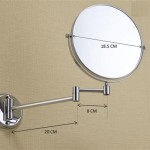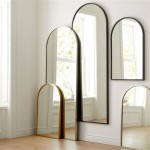How To Hang A Heavy Mirror Without Using Nails
Hanging a heavy mirror can be a challenge, especially if you want to avoid damaging your walls. Nails are a traditional solution, but they can leave unsightly holes and may not be suitable for all wall types. Fortunately, there are several effective methods for hanging heavy mirrors without using nails, offering a more secure and damage-free alternative. This article explores different approaches, examining their pros and cons to help you choose the best option for your specific needs.
Using Adhesive Strips
Adhesive strips are a popular option for hanging lightweight items, but they can also handle surprisingly heavy objects like mirrors, particularly when using heavy-duty strips designed for this purpose. These strips consist of two parts: a sticky pad that adheres to the wall and a hook or tab that attaches to the mirror. The adhesive provides a strong grip, holding the mirror firmly in place.
Pros:
- Easy installation: Adhesive strips require no drilling or hammering, making installation quick and straightforward.
- Damage-free: They leave no holes or marks on the wall, making them ideal for renters or those with delicate walls.
- Removable: Adhesive strips can be removed without leaving behind any residue, allowing you to reposition the mirror or change your decor.
Cons:
- Weight limitations: While heavy-duty strips can hold significant weight, they are not suitable for extremely heavy mirrors.
- Surface compatibility: Adhesive strips work best on smooth, non-porous surfaces like painted walls or tile. They may not be as effective on textured walls or wallpaper.
- Temperature sensitivity: Extreme temperatures can affect the adhesive strength, potentially causing the mirror to fall.
Utilizing Command Hooks
Command hooks are another popular alternative to nails, offering similar ease of installation and damage-free removal. They come in various sizes and weight capacities, allowing you to choose the appropriate hook for your mirror. Command hooks use a pressure-sensitive adhesive that firmly attaches to the wall, creating a secure hold.
Pros:
- Easy installation and removal: Like adhesive strips, Command hooks are simple to install and remove without damaging the wall.
- Versatile hanging options: Command hooks are available in different shapes and sizes, allowing you to choose the best option for your mirror and hanging style.
- Weight capacity: Command hooks offer a range of weight capacities, with some models capable of holding relatively heavy mirrors.
Cons:
- Limited weight capacity: While Command hooks can handle some weight, they may not be suitable for extremely heavy mirrors.
- Surface compatibility: Like adhesive strips, Command hooks are best suited for smooth surfaces and may not work well on textured walls or wallpaper.
- Potential for peeling: Over time, Command hooks may lose their adhesive strength, especially if they are repeatedly removed and reapplied.
Employing Hanging Wire and D-Rings
For heavier mirrors, using hanging wire and D-rings provides a more robust solution. D-rings are metal rings that attach to the back of the mirror, while a hanging wire connects to the rings and is secured to a wall-mounted hook or picture-hanging system. This method distributes the weight more evenly, reducing the stress on the wall and the hanging system.
Pros:
- Stronger support: Hanging wire and D-rings are designed to handle significant weight, making them ideal for heavy mirrors.
- Adjustable height: The hanging wire allows you to adjust the height of the mirror easily.
- Wall-mounted options: You can use hooks, picture-hanging systems, or even specialized wall anchors for securing the hanging wire.
Cons:
- Installation requires tools: Installing D-rings and hanging wire may require tools like a drill and screwdriver depending on the chosen method.
- Potential for wall damage: While using wall anchors or picture-hanging systems minimizes damage, there is still a risk of minor holes or marks, unlike adhesive strips and Command hooks.
- Less discreet: The visible hanging wire can detract from the mirror's aesthetic if not carefully concealed.
Ultimately, the best method for hanging a heavy mirror without using nails depends on the weight of the mirror, the type of wall surface, and your personal preferences. Carefully consider the pros and cons of each option before making a decision.

How To Hang A Mirror On Wall Without Nails
How To Hang A 100 Pound Mirror On Drywall Quora

How To Hang A Mirror On Wall Without Nails Guide For All Diyers

Hang Mirror Without Nail Or

3 Simple Ways To Hang A Mirror On Wall Without Nails Wikihow

How To Hang Heavy Mirrors Frames Without Nails 3m

How To Hang A Hanging Mirror Without Accompanying Hardware

How To Hang A Heavy Mirror Or Picture True Value
How To Hang Large Pictures Without Using Nails

Hanging Heavy Mirror Without A Stud Tiktok Search








